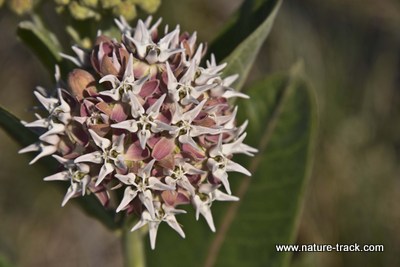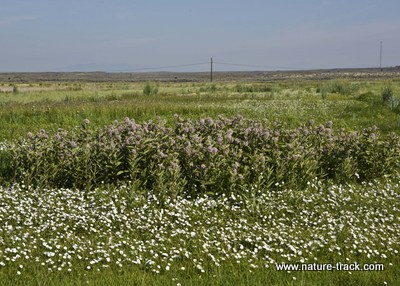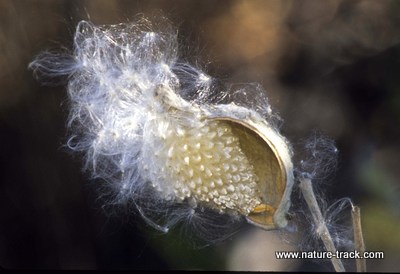Milkweed Supports Monarchs

Common milkweed may be shunned by many landowners and gardeners, but monarch butterflies not only love it, it is absolutely essential for their life cycle.

Common milkweed can quickly form exclusive clones via rhizomes that sprout new plants along their length.

The pod and seeds of a milkweed plant are photogenic.
An annual war is forming up on the canals and ditchbanks, fields, farms and backyards all across the country. On the one side is a pretty pink wildflower called common milkweed. Landowners are on the other side, armed with an array of chemicals loaded into tanks pulled by tractors, carried by ATVs or even by backpacks, and marking their battlelines with blue dye. Anything short of milkweed annihilation seems to be unacceptable.
It is easy to see why landowners might resent this native plant. It is a perennial that not only reproduces through copious seed production but by rhizomes as well. Rhizomes are lateral roots that shoot from the mother plant at an astonishing rate and form numerous new sprouts. They can quickly create a milkweed colony where other plants cannot grow.
To see where milkweed gets its name, cause a little injury to a milkweed stalk. A sticky white sap will immediately begin to ooze out and run down the stem, much like a milky tear. This milky sap is full of toxins known as cardiac glycosides, making this plant poisonous to most animals, humans included.
Milkweed has several redeeming qualities though. First, the pink five-petaled flowers form up in a pretty globe on top of handsome green foliage.
Second, milkweed is attractive to many beneficial insects, providing pollen, nectar and escape cover.
Third, milkweed is the host, the only host, to monarch butterfly caterpillars which can absorb the toxins making themselves poisonous in the process. The relationship between milkweed and monarchs is similar to that between sagebrush and sage-grouse. The plant thrives without the animal, but the animal’s biology is hardwired to the plant.
It’s that third one that should give pause to the war on milkweed. Monarch numbers are dropping fast, and researchers tie it directly to the decline of common milkweed. To save a milkweed is, quite possibly, to save a monarch and thus a species.
Despite its beautiful flowers and foliage, despite the fact that the late summer seedpods are works of art, even despite the fact that monarchs must have them, for me, our native milkweed is not a plant to welcome in a small backyard.
Once, in an attempt to do my part for monarch conservation, I allowed, even encouraged, a single milkweed plant in my garden. By the second year, I had milkweed runners 12 feet from the mother plant. Feeling two-faced, yet fearing a hostile takeover, I too went to war and battle this same plant today. Its aggressive nature may be best suited for fields and woodlands. There are other species of milkweed, such as butterfly milkweed, that will still satisfy a monarch caterpillar yet won’t overwhelm the garden.
If milkweed existed for only one reason, as life support for monarch butterflies, for me that would be enough reason to preserve and even perpetuate it. It would be hard to imagine a world where monarchs no longer fly simply because humans were intolerant of the plant that sustains them.

Wildlife License Plates
Great news! as of 2024, there are three NEW designs for license plates. They still are bluebird, cutthroat trout and elk, but they are beautiful.
Idaho Wildlife license plates provide essential funding that benefits the great diversity of native plants and wildlife that are not hunted, fished or trapped—over 10,000 species or 98% of Idaho’s species diversity. Game species that share the same habitats (such as elk, deer, antelope, sage-grouse, salmon, trout) also benefit from these specialty plates.
No state tax dollars are provided for wildlife diversity, conservation education and recreation programs. Neither are any revenues from the sale of hunting or fishing licenses spent on nongame species. Instead, these species depend on direct donations, federal grants, fundraising initiatives—and the Idaho Wildlife license plates.
Both my vehicles have Bluebird Plates. I prefer the bluebird because the nongame program gets 70 percent of the money from bluebird plates, but only 60 percent of the money from elk and trout plates - 10 percent of the money from elk plates supports wildlife disease monitoring and testing programs (to benefit the livestock industry) and 10 percent from cutthroat plates supports non-motorized boat access.
Incidentally, in 2014, the Idaho Legislature denied the Department of Fish and Game the ability to add new plates or even to change the name of the elk and cutthroat plates (very specific) to wildlife and fish plates, a move that would have allowed for changing images occasionally and generating more revenue. It would seem that they believe that we Idahoans don't want a well funded wildlife program.
I think it is time we let the Legislature know that Idahoan support wildlife funding and that we would like to see these generic plates come to fruition.

"WOW. What a phenomenal piece you wrote. You are amazing." Jennifer Jackson
That is embarrassing, but actually a fairly typical response to my nature essays. Since The Best of Nature is created from the very best of 16 years of these nature essays published weekly in the Idaho Falls Post Register (online readership 70,000), it is a fine read. It covers a wide variety of topics including humorous glimpses of nature, philosophy, natural history, and conservation. Readers praise the style, breadth of subject matter and my ability to communicate complex and emotional topics in a relaxed and understandable manner.
Everyone can find something to love in this book. From teenagers to octogenarians, from the coffee shop to the school room, these nature essays are widely read and enjoyed.
Some of the essays here are my personal favorites, others seemed to strike a chord with readers. Most have an important message or lesson that will resonate with you. They are written with a goal to simultaneously entertain and educate about the wonderful workings of nature. Some will make you laugh out loud and others will bring a tear to the eye and warm your heart.
Readers Write:
"You hit a home run with your article on, Big Questions in Nature. It should be required reading for everyone who has lost touch with nature...great job!" Joe Chapman
"We enjoyed your column, Bloom Where Planted. Some of the best writing yet. The Post Register is fortunate to have your weekly columns." Lou Griffin.
To read more and to order a copy, click here or get the Kindle version
Copies are also available at:
Post Register
Island Park Builders Supply (upstairs)
Barnes and Noble in Idaho Falls
Harriman State Park, Island Park
Museum of Idaho
Valley Books, Jackson Wyoming
Avocet Corner Bookstore, Bear River National Wildlife Refuge, Brigham City, Utah
Craters of the Moon National Monument Bookstore, Arco, Idaho